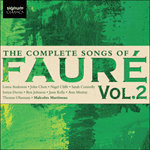Catulle Mendès was more or less a contemporary of Fauré’s. By the time that the composer alighted on his work in 1902 the seventy-year-old poet was resting on old laurels—he had been, after all, Gautier’s son-in-law, Chabrier’s librettist, the lover of Augusta Holmès. This is a modern
Fleur jetée written eighteen years after that famously tricky song from 1884 with its
Erlkönig-like repeated octaves. There the flower is thrown to the winds, here it is tossed by stormy waves. The accompaniment for
La fleur qui va sur l’eau trumps
Fleur jetée in terms of difficulty. The amount of tension generated by these restless semiquavers oscillating between the hands is tremendous. This must be one of the most ingenious, as well as the most maddeningly tricky, accompanying patterns ever devised by a composer—the fingery detail that sets this cauldron a-bubble also manages to suggest something fragile bobbing on the surface of the sea. The singer receives no help at all from the pianist in maintaining his own rhythm; in the midst of a maelstrom of notes he must count or die (the terms ‘at sea’ or ‘cut adrift’ come to mind). The accompaniment becomes calmer as the song progresses; by the last page broad groups of quavers, and an elegiac vocal line, suggest a bitter requiem for lost struggles. Perhaps Mendès has in mind a floral metaphor for a beautiful woman drowned and afloat, a symbolist Ophelia. The imagery of the rose’s union with the sea, an aquatic deflowering, could also be seen as a symbol of a disgrace that has led to suicide. There is certainly a rage to this music (‘un air irrité’, at the very least) that suggests a dramatic subtext of this kind. The song has been compared to
La vague et la cloche; it deserves at least as many performances as Duparc’s quasi-operatic blockbuster, but its difficulties (which do not sound as formidable as they prove to be under the fingers and in the voice) have discouraged generations of singers and pianists.
from notes by Graham Johnson © 2005
En 1902, lorsque Fauré découvrit l’œuvre de Catulle Mendès, son quasi-contemporain, le poète septuagénaire se reposait sur ses vieux lauriers—n’avait-il pas été, au fond, le beau-fils de Gautier, le librettiste de Chabrier et l’amant d’Augusta Holmès?
La fleur qui va sur l’eau est une
Fleur jetée moderne, de dix-huit ans postérieure à cette fameuse mélodie de 1884 ardue, avec ses octaves répétées à la
Erlkönig. Ici, la fleur n’est plus jetée aux vents mais ballotée par des flots tempétueux, et l’accompagnement surpasse en difficulté celui de
Fleur jetée. La tension générée par les doubles croches agitées, qui oscillent entre les mains, est immense, et ce doit être l’un des schémas d’accompagnement les plus ingénieux (les plus exaspérants de difficultés, aussi) jamais conçus par un compositeur—les détails digitaux qui font bouillonner ce chaudron parviennent, en outre, à suggérer quelque chose de fragile dansant à la surface de l’eau. Le chanteur doit maintenir son rythme sans aucune aide du pianiste: pris au cœur d’un maelström de notes, il lui faut compter ou périr (les termes «en mer» ou «mis à la dérive» viennent à l’esprit). L’accompagnement s’apaise à mesure que la mélodie progresse; à la dernière page, de larges groupes de croches, et une ligne vocale élégiaque, évoquent un amer requiem pour les batailles perdues. Peut-être Mendès a-t-il songé à une métaphore florale pour signifier une splendide noyée, flottant à la surface de l’eau—une Ophélie symboliste. L’image de l’union de la rose avec la mer, une défloration aquatique, a également pu être regardée comme le symbole d’une disgrâce ayant mené au suicide. Il y a assurément une rage dans cette musique («un air irrité», à tout le moins) qui suggère pareille lecture dramatique du texte. D’aucuns comparèrent cette mélodie à
La vague et la cloche; de fait, elle mérite au moins autant d’interprétations que cet immense succès, quasi opératique, de Duparc, mais ses difficultés (qui ne semblent pas, à l’écoute, aussi formidables qu’elles le sont, en réalité, pour les interprètes) ont découragé des générations de pianistes et de chanteurs.
extrait des notes rédigées par Graham Johnson © 2005
Français: Hypérion


 Fauré: The Complete Songs, Vol. 2
Fauré: The Complete Songs, Vol. 2
